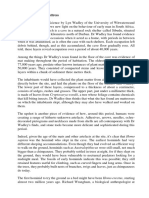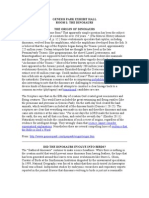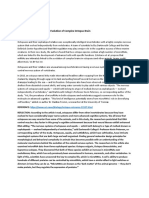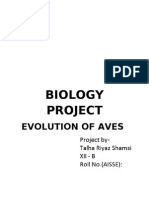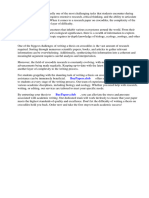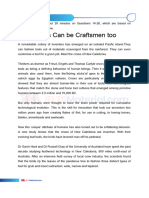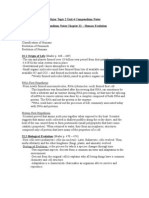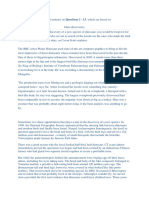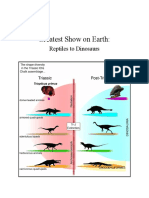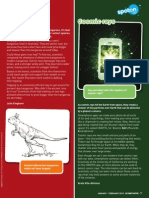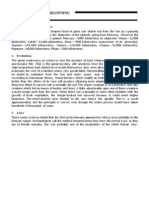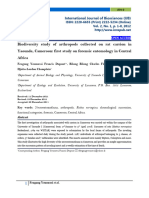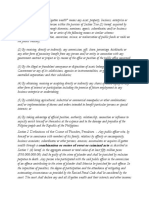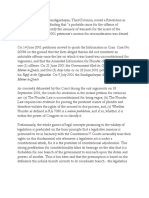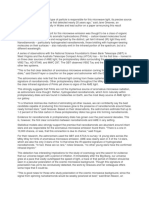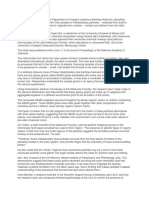Dino-Bird Dandruff Research Head and Shoulders Above Rest
Dino-Bird Dandruff Research Head and Shoulders Above Rest
Uploaded by
sashinaCopyright:
Available Formats
Dino-Bird Dandruff Research Head and Shoulders Above Rest
Dino-Bird Dandruff Research Head and Shoulders Above Rest
Uploaded by
sashinaOriginal Description:
Original Title
Copyright
Available Formats
Share this document
Did you find this document useful?
Is this content inappropriate?
Copyright:
Available Formats
Dino-Bird Dandruff Research Head and Shoulders Above Rest
Dino-Bird Dandruff Research Head and Shoulders Above Rest
Uploaded by
sashinaCopyright:
Available Formats
Dino-bird dandruff research head and shoulders above
rest
UCC's Dr Maria McNamara and her team studied the fossil cells, and dandruff from modern birds, with
powerful electron microscopes for the study, published today in the journal Nature Communications.
"The fossil cells are preserved with incredible detail -- right down to the level of nanoscale keratin fibrils.
What's remarkable is that the fossil dandruff is almost identical to that in modern birds -- even the spiral
twisting of individual fibres is still visible," said Dr Maria McNamara.
Just like human dandruff, the fossil dandruff is made of tough cells called corneocytes, which in life are dry
and full of the protein keratin.
The study suggests that this modern skin feature evolved sometime in the late Middle Jurassic, around the
same time as a host of other skin features evolved. "There was a burst of evolution of feathered dinosaurs and
birds at this time, and it's exciting to see evidence that the skin of early birds and dinosaurs was evolving
rapidly in response to bearing feathers," Dr McNamara added.
Dr McNamara led the study, in collaboration with her postdoctoral researcher Dr Chris Rogers; Dr Andre
Toulouse and Tara Foley, also from UCC; Dr Paddy Orr from UCD, Ireland; and an international team of
palaeontologists from the UK and China.
The dandruff is the first evidence of how dinosaurs shed their skin. The feathered dinosaurs studied --
Microraptor, Beipiaosaurus and Sinornithosaurus -- clearly shed their skin in flakes, like the early bird
Confuciusornis studied by the team and also modern birds and mammals, and not as a single piece or several
large pieces, as in many modern reptiles.
Co-author Professor Mike Benton, from the University of Bristol's School of Earth Sciences, said: "It's unusual
to be able to study the skin of a dinosaur, and the fact this is dandruff proves the dinosaur was not shedding its
whole skin like a modern lizard or snake but losing skin fragments from between its feathers."
Modern birds have very fatty corneocytes with loosely packed keratin, which allows them to cool down
quickly when they are flying for extended periods. The corneocytes in the fossil dinosaurs and birds, however,
were packed with keratin, suggesting that the fossils didn't get as warm as modern birds, presumably because
they couldn't fly at all or for as long periods.
You might also like
- Untitled Document 13Document7 pagesUntitled Document 13api-410720882No ratings yet
- How Birds Evolved From Dinosaurs 20150602Document8 pagesHow Birds Evolved From Dinosaurs 20150602Niranjana Prasanna VenkateswaranNo ratings yet
- Media Release EMBARGO Digging Up New Facts On Australia and PNG Giant Fossil KangaroosDocument2 pagesMedia Release EMBARGO Digging Up New Facts On Australia and PNG Giant Fossil Kangaroosdelaney.angusNo ratings yet
- Ascent of The Mammals: Scientific American May 2016Document9 pagesAscent of The Mammals: Scientific American May 2016Rodrigo GRNo ratings yet
- Evolusi KelelawarDocument4 pagesEvolusi KelelawarRusmidin LaNo ratings yet
- Darwinism Behind Becoming The Largest Creature: Pushpendra 19BCS0041Document1 pageDarwinism Behind Becoming The Largest Creature: Pushpendra 19BCS0041ShivamNo ratings yet
- Did Dinosaurs Have FeathersDocument2 pagesDid Dinosaurs Have Featherstito operaNo ratings yet
- Biology 1010Document4 pagesBiology 1010api-316626257No ratings yet
- How Birds Got Their WingsDocument2 pagesHow Birds Got Their WingsCarlos BellatinNo ratings yet
- Bianca Neale Argument Essay 1Document5 pagesBianca Neale Argument Essay 1api-451594265No ratings yet
- The CACAO A Sweet HistoryDocument48 pagesThe CACAO A Sweet HistoryIbrahim KhleifatNo ratings yet
- Untitleddocument 2Document2 pagesUntitleddocument 2api-239502824No ratings yet
- Green Modern Environment PresentationDocument73 pagesGreen Modern Environment PresentationFrancis Hassel PedidoNo ratings yet
- Did Neurons Evolve TwiceDocument7 pagesDid Neurons Evolve TwiceSilvino González MoralesNo ratings yet
- Scientists Offer More Evidence On What Dinosaurs Looked Like - NYTimesDocument2 pagesScientists Offer More Evidence On What Dinosaurs Looked Like - NYTimeslsardinasNo ratings yet
- Phyl Ogen y of Phylum ChordataDocument10 pagesPhyl Ogen y of Phylum Chordatamirandajealyn28No ratings yet
- Ielts Mock TestDocument4 pagesIelts Mock TestPhong ThầnNo ratings yet
- Book of Dinosaurs, 1998, P. 12.) Some Evolutionists Speculate That Reptiles, IncludingDocument4 pagesBook of Dinosaurs, 1998, P. 12.) Some Evolutionists Speculate That Reptiles, IncludingIrish Pauline L. EreñoNo ratings yet
- Origin and Evolution of Birds: Read: Chapters 1-3 in Gill But Limited Review of SystematicsDocument37 pagesOrigin and Evolution of Birds: Read: Chapters 1-3 in Gill But Limited Review of SystematicsBernatNo ratings yet
- Bio ArticleDocument2 pagesBio ArticleAlize SantschiNo ratings yet
- Biology Project: Evolution of AvesDocument14 pagesBiology Project: Evolution of AvesFaria ZakirNo ratings yet
- Passage 1 Is Adapted From © 2005 by Public Library of Science. Passage 2 Is Adapted From Tim Heupink, Et Al. © 2014 by Biomed CentralDocument3 pagesPassage 1 Is Adapted From © 2005 by Public Library of Science. Passage 2 Is Adapted From Tim Heupink, Et Al. © 2014 by Biomed CentralsofaNo ratings yet
- Carlsbad Caverns: Bat ResearchDocument2 pagesCarlsbad Caverns: Bat ResearchGoce VasilevskiNo ratings yet
- 1111 Amazing Facts about Animals: Dinosaurs, dogs, lizards, insects, sharks, cats, birds, horses, snakes, spiders, fish and more!From Everand1111 Amazing Facts about Animals: Dinosaurs, dogs, lizards, insects, sharks, cats, birds, horses, snakes, spiders, fish and more!No ratings yet
- BatsDocument6 pagesBatskeithNo ratings yet
- 09 The Evolution of Flight in Bats A Novel HypothesisDocument14 pages09 The Evolution of Flight in Bats A Novel Hypothesisberenice simonNo ratings yet
- The Complete Insect: Anatomy, Physiology, Evolution, and EcologyFrom EverandThe Complete Insect: Anatomy, Physiology, Evolution, and EcologyDavid A. GrimaldiNo ratings yet
- Dinosaurs-And-The-Secrets-They-Still-Hold 04-Mar-2022Document5 pagesDinosaurs-And-The-Secrets-They-Still-Hold 04-Mar-2022olimjonuvayzov6807No ratings yet
- Research Paper On CrocodilesDocument8 pagesResearch Paper On Crocodilesl1wot1j1fon3100% (1)
- Velociraptor Facts For KidsDocument1 pageVelociraptor Facts For Kidsneiroca1974No ratings yet
- DinosaursDocument11 pagesDinosaurspreyamvada sNo ratings yet
- WaterbearsDocument5 pagesWaterbears76stchstchNo ratings yet
- Science, Level 4, Practice 2Document5 pagesScience, Level 4, Practice 2vicky chanNo ratings yet
- Day 30 PDocument6 pagesDay 30 PHuseynov SardorNo ratings yet
- Crows Can Be Craftsmen TooDocument3 pagesCrows Can Be Craftsmen Toonisrina0nurfitriaNo ratings yet
- Major Topic 2 Unit 4 Compendium NotesDocument10 pagesMajor Topic 2 Unit 4 Compendium NoteswillwatermanNo ratings yet
- Scientists Solve The Riddle of Zebras' StripesDocument2 pagesScientists Solve The Riddle of Zebras' StripesSyma ShaheenNo ratings yet
- 7.dino Discoveries, Art To The Aid of Technology, Mind ReadersDocument12 pages7.dino Discoveries, Art To The Aid of Technology, Mind ReadersAkash SarkarNo ratings yet
- Palaeontologists Think They Have Found 'The Most Dangerous Place' in Earth's HistoryDocument11 pagesPalaeontologists Think They Have Found 'The Most Dangerous Place' in Earth's HistorySofi ArevaloNo ratings yet
- Cloning in Jurassic ParkDocument5 pagesCloning in Jurassic ParkAbigail WilliamsNo ratings yet
- Science ProjectDocument6 pagesScience Projectapi-447987846No ratings yet
- Padian OriginBirdsFlight 1998Document11 pagesPadian OriginBirdsFlight 1998Mario FloresNo ratings yet
- EarthDate 113 CDocument3 pagesEarthDate 113 CAigounNo ratings yet
- Digging for Bird-Dinosaurs: An Expedition to MadagascarFrom EverandDigging for Bird-Dinosaurs: An Expedition to MadagascarRating: 3.5 out of 5 stars3.5/5 (13)
- Albatrosses Counted From Space: by Jonathan Amos From The SectionDocument13 pagesAlbatrosses Counted From Space: by Jonathan Amos From The Sectionsaras qtNo ratings yet
- Albatrosses Counted From Space: by Jonathan Amos From The SectionDocument13 pagesAlbatrosses Counted From Space: by Jonathan Amos From The Sectionsaras qtNo ratings yet
- Evolutionary History of Tuatara Clearly Mapped For The First TimeDocument2 pagesEvolutionary History of Tuatara Clearly Mapped For The First TimeNg TanhNo ratings yet
- FullDocument5 pagesFullmashablescribdNo ratings yet
- National Geographic BiomimeticsDocument10 pagesNational Geographic BiomimeticsAngelaTarazonaNo ratings yet
- Scientriffic-95 Cosmic RaysDocument1 pageScientriffic-95 Cosmic Raysapi-285324421No ratings yet
- Dinosaur PDF 2Document3 pagesDinosaur PDF 2Su MyatNo ratings yet
- The World in The BeginningDocument3 pagesThe World in The BeginningMichael JohnstonNo ratings yet
- 7-Dinosaurs-Mortenson-128 Eng CR 7107 v6Document129 pages7-Dinosaurs-Mortenson-128 Eng CR 7107 v6scienceandapologeticsNo ratings yet
- Cats Are Capable of Mind Control: And 1,000+ UberFacts You Never Knew You Needed to KnowFrom EverandCats Are Capable of Mind Control: And 1,000+ UberFacts You Never Knew You Needed to KnowRating: 4 out of 5 stars4/5 (2)
- Biodiversity Study of Arthropods Collected On Rat Carrion in Yaounde, Cameroon: First Study On Forensic Entomology in Central AfricaDocument8 pagesBiodiversity Study of Arthropods Collected On Rat Carrion in Yaounde, Cameroon: First Study On Forensic Entomology in Central AfricaOpenaccess Research paperNo ratings yet
- KNOWN INSECTS OF UNKNOWN WORLD BioDocument12 pagesKNOWN INSECTS OF UNKNOWN WORLD BioSayan LodhNo ratings yet
- Section 1: The Ielts HubDocument14 pagesSection 1: The Ielts HubTHE IELTS HUBNo ratings yet
- How Science WorksDocument3 pagesHow Science WorksNathaniel LanceNo ratings yet
- Evolution of DragonfliesDocument8 pagesEvolution of DragonfliesKukuhRiyanAl-MaulanaAdzhiemNo ratings yet
- Terrorem Effect Resulting From Their Very Existence, And, If Facial Challenge IsDocument2 pagesTerrorem Effect Resulting From Their Very Existence, And, If Facial Challenge IssashinaNo ratings yet
- Doubt Is To Sustain."Document1 pageDoubt Is To Sustain."sashinaNo ratings yet
- Combination or Series of Overt or Criminal ActsDocument2 pagesCombination or Series of Overt or Criminal ActssashinaNo ratings yet
- Motion To Quash, and Five (5) Days Later or On 26 June 2001 Petitioner Submitted Motion To QuashDocument1 pageMotion To Quash, and Five (5) Days Later or On 26 June 2001 Petitioner Submitted Motion To QuashsashinaNo ratings yet
- Hurricanes: Stronger, Slower, Wetter in The Future?Document2 pagesHurricanes: Stronger, Slower, Wetter in The Future?sashinaNo ratings yet
- I Had Given Up All Hope, When This Brave Liegeman Came To Our AidDocument1 pageI Had Given Up All Hope, When This Brave Liegeman Came To Our AidsashinaNo ratings yet
- His Body Did BurstDocument1 pageHis Body Did BurstsashinaNo ratings yet
- Giant Invasive Flatworms Found in France and Overseas French TerritoriesDocument1 pageGiant Invasive Flatworms Found in France and Overseas French TerritoriessashinaNo ratings yet
- How Animals Holler: Moving Air EfficientlyDocument2 pagesHow Animals Holler: Moving Air EfficientlysashinaNo ratings yet
- A Lustre Unlovely Likest To FireDocument1 pageA Lustre Unlovely Likest To FiresashinaNo ratings yet
- Gainst The FriendDocument1 pageGainst The FriendsashinaNo ratings yet
- Gainst The FriendDocument1 pageGainst The FriendsashinaNo ratings yet
- Proceedings of The National Academy of SciencesDocument2 pagesProceedings of The National Academy of SciencessashinaNo ratings yet
- Diamond DustDocument2 pagesDiamond DustsashinaNo ratings yet
- Experiments Trace Interstellar DustDocument2 pagesExperiments Trace Interstellar DustsashinaNo ratings yet
- Artificial IntelligenceDocument2 pagesArtificial IntelligencesashinaNo ratings yet
















